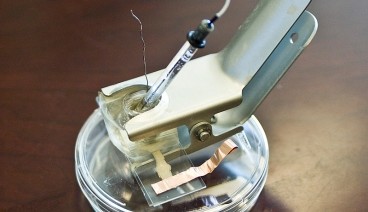Regenerating Solar Cells
September 08, 2010
on
on

Something that struck me while I was reading up on MIT's latest news on the development of a new type of solar cell, was that the sun (eventually) destroys conventional solar cells. This never ocurred to me, while I recently visited Morocco and can see how the sun pounding on everything everyday can be quite destructive...
Anyway, I wouldn't have read this on MIT News if it wouldn't be for an MIT invention dealing with the problem. And what's better, the team at MIT took their inspiration for the solution from nature. Plants constantly recycle their photosynthetic cells, so the sun rays they capture are always absorbed by brand new and efficient cells.
This process of recycling is triggered by the sunlight itself - or to be more precise, by the oxygen it produces. It results in a clean cycle: sunlight triggers the breakdown of cells inside the chloroplasts (where the photosynthesis happens), the breakdown triggers the recomposition of these cells, new cells capture sunlight, they breakdown, recompose, ad infinitum.
Now to translate this to technology, the team recreated the chloroplasts by producing very tiny disks that carry photosynthetic structures called 'reaction centers'. They put the disks into a solution together with some highly conductive carbon nanotubes. The disks attach to the nanotubes, keeping them aligned.
The magic happens when the researchers add a 'surfactant' - a liquid that reduces surface tension - to this mix. All components break down and turn into a nondescript soupy liquid. By removing this surfactant, the structures reassemble themselves into fresh structures.
The team built a prototype and had it cycled for 14 hours straight, without a loss in efficiency. While this sounds interesting, and while I love the approach the researchers took, I wonder if this could ever be turned into a practical, real-world proof and cheap system. It does sound pretty delicate.
[newsletter]
Anyway, I wouldn't have read this on MIT News if it wouldn't be for an MIT invention dealing with the problem. And what's better, the team at MIT took their inspiration for the solution from nature. Plants constantly recycle their photosynthetic cells, so the sun rays they capture are always absorbed by brand new and efficient cells.
This process of recycling is triggered by the sunlight itself - or to be more precise, by the oxygen it produces. It results in a clean cycle: sunlight triggers the breakdown of cells inside the chloroplasts (where the photosynthesis happens), the breakdown triggers the recomposition of these cells, new cells capture sunlight, they breakdown, recompose, ad infinitum.
Now to translate this to technology, the team recreated the chloroplasts by producing very tiny disks that carry photosynthetic structures called 'reaction centers'. They put the disks into a solution together with some highly conductive carbon nanotubes. The disks attach to the nanotubes, keeping them aligned.
The magic happens when the researchers add a 'surfactant' - a liquid that reduces surface tension - to this mix. All components break down and turn into a nondescript soupy liquid. By removing this surfactant, the structures reassemble themselves into fresh structures.
The team built a prototype and had it cycled for 14 hours straight, without a loss in efficiency. While this sounds interesting, and while I love the approach the researchers took, I wonder if this could ever be turned into a practical, real-world proof and cheap system. It does sound pretty delicate.
Via MIT News
[newsletter]
Read full article
Hide full article


Discussion (0 comments)